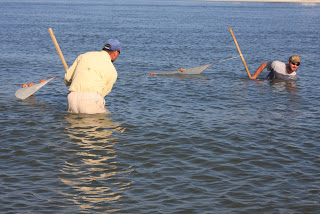What has blue blood, feet around its mouth and 10 eyes and legs? The Horseshoe Crab - which isn't a crab at all, but an arthropod that shares a few similarities with other arthropods like spiders and crabs. They predate the dinosaurs and are most closely related to trilobites.

We didn't catch any in our seine netting on Saturday, but a walk in the mud flats at low tide revealed a few bulldozing their way through the mud in search of shelter. This area is essentially a nursery for young crabs. They molt several times in their first 2 years and by the time they get to be this size - maybe once a year - discarding the entire "shell" as they grow.

This young adult was hunkering down in a small pool of brackish water. They prefer the back bays and coves that have low wave energy. This species (of which there are 4 worldwide) is found from New Jersey south to the Gulf of Mexico. The greatest abundance of Horseshoe Crabs is in Delaware Bay where hundreds of thousands of migrating birds stop in to munch on the crab's eggs. Fortunately each female can lay up to 80,000 eggs (yet populations have been declining).

Our instructor placed it upside down to demonstrate how they can do a somersault to right themselves. Here you can see the 10 crab-like legs that surround the mouth (Like the alien in the movie Predator).

The crab is able to use its tail to roll itself over.
And flip itself to a more natural position. Not all are capable of doing so and in some Atlantic states they have instituted a "Just Flip Em" campaign to encourage beach goers to flip the harmless creatures over.
They have light sensitive organs or "eyes" on the front end as well as on their tail that allow them to see the light spectrum that we see as well as ultra violet light.
Despite what looks like a tough exterior, the exoskeleton is relatively fragile. Below - the Horseshoe Crab has burrowed into the mud. A walk in the mud flats is like walking on eggshells if you don't take care - fiddler and horseshoe crabs abound.

Technically their blood is not blue but when exposed to oxygen it turns blue. The blood has been important in medical research as scientists look at the bacteria resistant properties and develop new ways to benefit from it. Currently an extract of Horseshoe Crab blood is used in vaccines and medical devices to prevent bacterial contamination.
They look benign from the road but the mudflat tidal zone is full of a diversity of life including the acrobatic "crabs".
For more info on Horseshoe Crabs check out http://horseshoecrab.org/nh/hist.html















